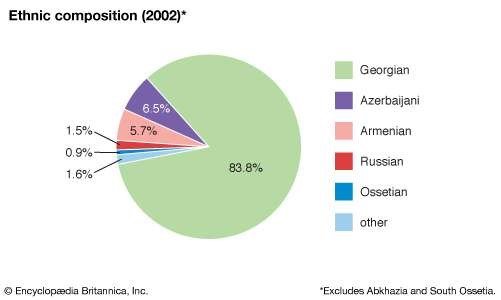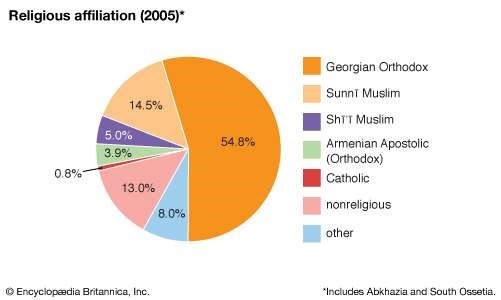
Ethnic Groups
The likelihood is great that the Georgians, whose name for themselves is Kartveli (“Georgian” derived from the Persian name for them, Gorj), have always lived in this region, known to them as Sakartvelo. Ethnically, contemporary Georgia is not homogeneous but reflects the intermixtures and successions of the Caucasus region. About four-fifths of the people are Georgians; the rest are Armenians, Russians, Azerbaijanis, and, in smaller numbers, Ossetes, Greeks, Abkhazians, and others.
Language
The Georgian language is a member of the Kartvelian (South Caucasian) family of languages. It has its own alphabet, which is thought to have evolved about the 5th century, and there are many dialects. A number of other Caucasian languages are spoken by minority groups; many are unwritten.
Religion
Many Georgians are members of the Georgian Orthodox Church, an autocephalous Eastern Orthodox church. In addition, there are Muslim, Russian Orthodox, Armenian Apostolic, Catholic, and Jewish communities.


Settlement Patterns
Population density in Georgia decreases with increasing altitude. The population of Georgia is concentrated in the narrow valley between the Greater Caucasus mountains in the north and the Lesser Caucasus in the south and along the coast of the Black Sea to the west. Population densities are relatively high but are less than those for Armenia and Azerbaijan.
Demographic Trends
The population of Georgia is aging. The birth rate is below the global average, while the death rate is above the world’s average. About one-fifth of the population is under age 15, and two-fifths are under 30, while another two-fifths are age 45 or older. Life expectancy is about 72 years for men and 81 years for women.

References : ENCYCLOPEDIA BRITANNICA

